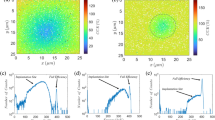Abstract
Since diamond can be used as both the substrate and the active medium in electronic devices, it is very important to obtain information concerning the temperature variations in the immediate vicinity of active elements and the conditions of heat removal from such elements. This task is solved by a bolometer built into a diamond plate, which is capable of measuring temperature increments induced by laser pulses in the diamond or in the diamond-supported surface structures. The bolometer, representing a buried graphitized layer formed by helium ion implantation with subsequent annealing, has a characteristic response time of ∼10 ns.
Similar content being viewed by others
References
V. B. Kvaskov, in Russia’s Natural Diamonds, Ed. by V. B. Kvaskov (Polyaron, Moscow, 1997), pp. 148–194.
A. A. Gippius, R. A. Khmelnitsky, V. A. Dravin, et al., Diamond Relat. Mater. 8, 1631 (1999).
T. I. Galkina, A. I. Sharkov, A. Yu. Klokov, et al., Pis’ma Zh. Éksp. Teor. Fiz. 64(4), 270 (1996) [JETP Lett. 64, 298 (1996)].
Author information
Authors and Affiliations
Additional information
__________
Translated from Pis’ma v Zhurnal Tekhnichesko\(\overset{\lower0.5em\hbox{$\smash{\scriptscriptstyle\smile}$}}{l} \) Fiziki, Vol. 27, No. 14, 2001, pp. 21–24.
Original Russian Text Copyright © 2001 by Klokov, Sharkov, Galkina, Khmel’nitskii, Dravin, Gippius.
Rights and permissions
About this article
Cite this article
Klokov, A.Y., Sharkov, A.I., Galkina, T.I. et al. A bolometric detector built into the diamond bulk. Tech. Phys. Lett. 27, 581–582 (2001). https://doi.org/10.1134/1.1388950
Received:
Issue Date:
DOI: https://doi.org/10.1134/1.1388950




